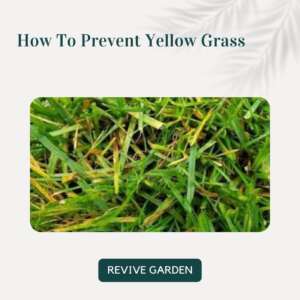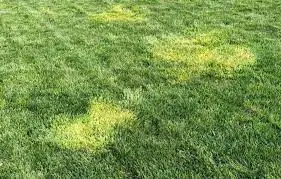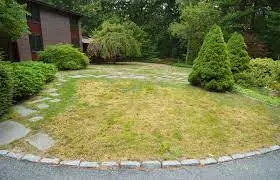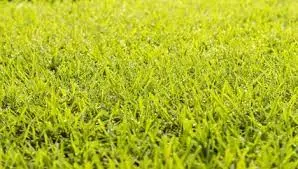Table of Contents
 A common misconception is that lawn diseases are to blame when grass becomes yellow. Yellowing can be caused by neglect or poor maintenance in some situations.
A common misconception is that lawn diseases are to blame when grass becomes yellow. Yellowing can be caused by neglect or poor maintenance in some situations.
Your grass is turning yellow in spots for a few different causes. Frost burn is the most prevalent reason for yellowing tips, but dog pee, too much fertilizer, and too much water can also contribute to the problem.
This article will focus on describing how to prevent yellow grass. When yellow spots form on your lawn, it cannot be charming because many people take pride in their gardens’ attractiveness. Fortunately, there are explanations and approaches to this problem.
Why Is The New Grass Turning Yellow? – Some Common Reasons
Lack of Nutrients
In most cases, this is what leads to lawns turning yellow. But, if there aren’t enough nutrients in the soil, the property will be unhealthy and more prone to pests and diseases. Yellow spots are widespread in the spring and are usually caused by an iron deficiency.
The addition of carbon-rich plants or organic stuff causes this. Organisms use nitrogen to break down carbon, but if it isn’t replaced, it can lead to nutrient shortages.
A lawn professional may analyze your soil’s composition and chemical levels to determine what’s missing and why your grass is dying.
Lawn Irrigation: Neither Too Little Nor Too Much
A lawn that isn’t watered as often as it needs to risks becoming weak and dying from lack of moisture. If you want fresh green grass, you need to water it twice daily, in the morning and the evening, regardless of the weather.
However, in really arid regions, watering your lawn three or more times per week is necessary to keep the grass green and the soil damp.
Moreover, once your grass has reached its full height, you should gradually decrease the frequency of your watering. Your grass must only be watered every two to five days, depending on the season, until it has fully grown. Your grass will turn yellow because overwatering prevents profound root growth.
Waterlogging occurs when excessive water reduces the amount of oxygen available. Because of this, your grass’s roots won’t be able to expand as they should, blocking its ability to take up the water and nutrients it requires. If you overwater your newly planted grass, it will become yellow.
Animals Urination

It is known that nitrogen compounds in dog urine are relatively high. Yellow patches on the grass are a common sign of dog urine damage.
Heat Excess
Depending on your grass, this could take as little as a few days. This may indicate that your grass has a weak root system. You could water your lawn to restore its color, but if you want to fix the underlying issue and stop it from happening again, you should try to promote deeper grassroots.
Do this by watering profoundly but less regularly. If you water your plants frequently, but with only a tiny amount each time, their roots will never send out shoots to find deeper soil, leaving them vulnerable to drying out in the heat.
Lawn Fungus
When turfgrasses are infected with fungi, the appearance of the individual leaf blades is altered. Diseases like dollar spot, which can be fatal to turf, often show up as yellowing of the grass blades near the soil.
Discoloration of lawn leaves due to frostbite is another potential issue. Frost damage causes mottled, yellowing, and eventually browning of the leaves in warm-season turfgrasses like zoysia and Bermuda grass.

You may stop the leaf yellowing and other symptoms of dollar spot and grey leaf spot on your lawn by applying a fungicide to the grass.
Mulch Cutters
Mowing the lawn has two significant effects on the grass:
- Grass becomes yellow when the blades are cut too short because they trap nutrients and water. Repeated occurrences of this problem could indicate that the mower’s blade height needs to be adjusted. So that the grass is tall enough to retain adequate water and nutrients for new growth.
- Grass can be harmed or killed by spilled gasoline from a lawn mower. To prevent soil contamination, you should fill the lawnmower somewhere distant from the grass and dilute the gas with water.
Overfertilization
For a lush and green lawn, avoid using too much fertilizer. You risk introducing salts that will burn and cause them to turn yellow. The discoloration of the turfgrass is likely due to the use of synthetic fertilizer. Symptoms of fertilizer burn include:
- The scorching of leaves caused by an excess of nitrogen salts
- The browning of grass blades
- Grass blades turning yellow at the base
- Grass with fertilizer crusts present
The extra salts that cause yellowing grass can be removed by irrigation. Using a quality organic slow-release fertilizer like Milorganite will help you achieve your goal of a thicker, greener lawn in a shorter amount of time.
Other Chemicals

Grass, in any of its life stages, from seedlings to mature turf, is vulnerable to damage from strong chemicals. Don’t use synthetic fertilizers or pesticides on your grass; discourage your pets from defecating there.
Road salt in colder climates has been known to turn grass yellow. If this happens, you’ll need to water the region heavily for a few days to get it back to normal.
Large Shaded Areas
Too much shade can gradually cause the grass to become yellow—most grasses used for lawns like direct or indirect sunlight. The grass will become yellow, grow sparsely with thin, elongated shoots, and become more prone to disease if it is in the shade for an extended period.
Best Practices For Preventing Yellow Grass In Your Lawn
- Find any low spots and cover them with dirt or sand to prevent water pooling. Disease transmission is hindered as a result of this.
- An effective drainage system and regular irrigation are essential for a green and flourishing lawn. If you need help figuring out which parts of your yard require better drainage, a landscaping company can give you a hand.
- The correct grass must be used! Many of us will go against the grain in hot climates and grow cool-season grass. The type of grass and turf you plant depends on the environment in your area.
- Fertilize regularly, but ensure the soil isn’t lacking anything.
- Upgrade your lawnmower with taller blades.
- Please don’t cut the grass unless it’s scorched.
- The soil can absorb water and oxygen better if little holes are drilled into it regularly.
Concluding Remarks
It’s disheartening to watch your fresh sod turn yellow. Nonetheless, due to the circumstances mentioned above, it occurs frequently. Make sure you’re looking for the indicators mentioned above if you want to trace the origins of the issue.
Then, with the help of our suggestions, you can deal with the problem at hand. This information will assist you in developing a lawn of which you can be justifiably proud. I hope that the grass is always greener on the other side of the fence for you.
